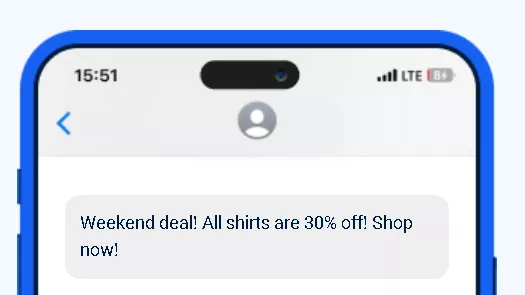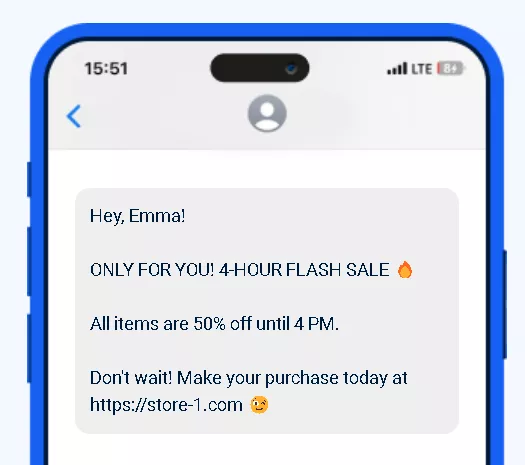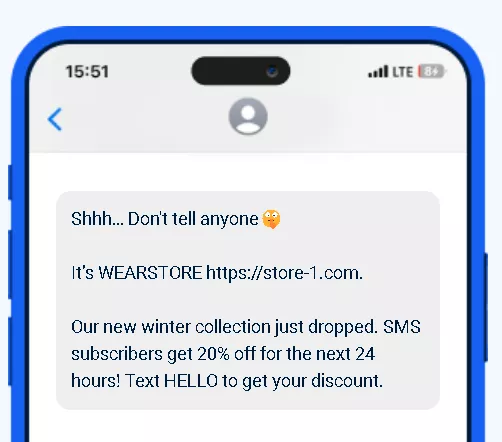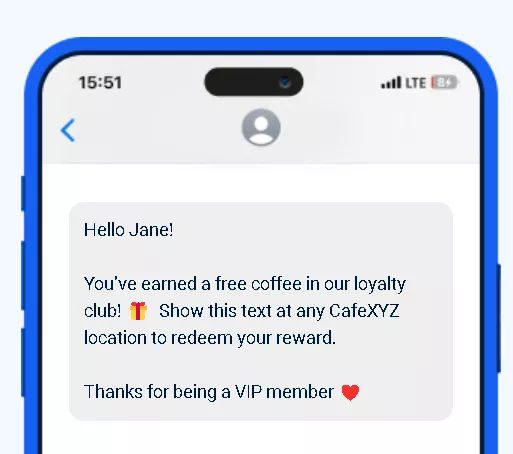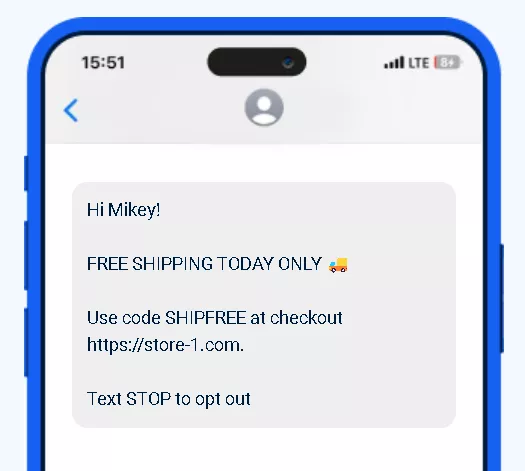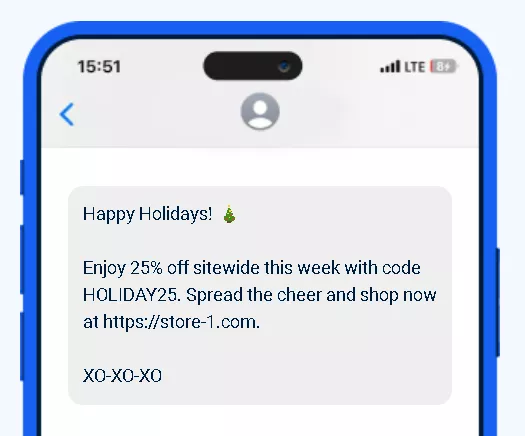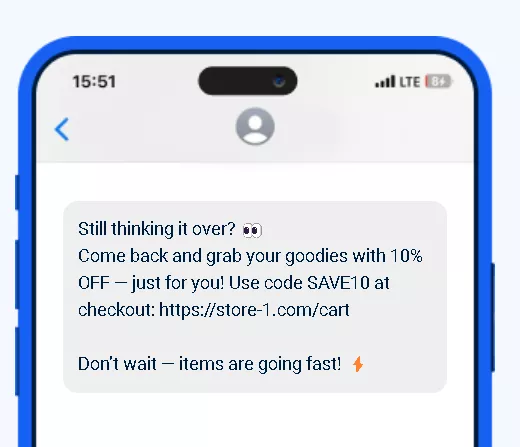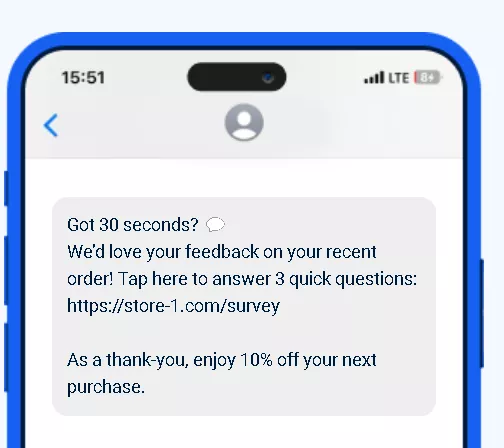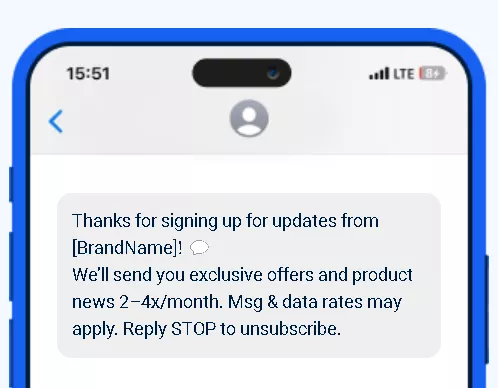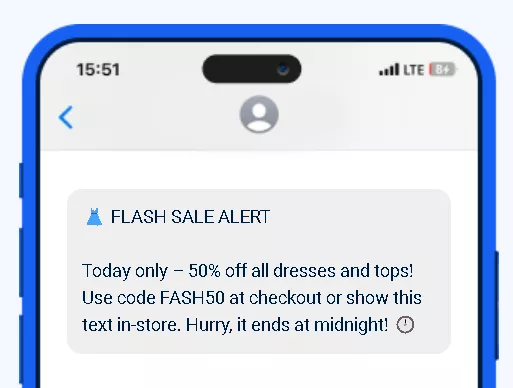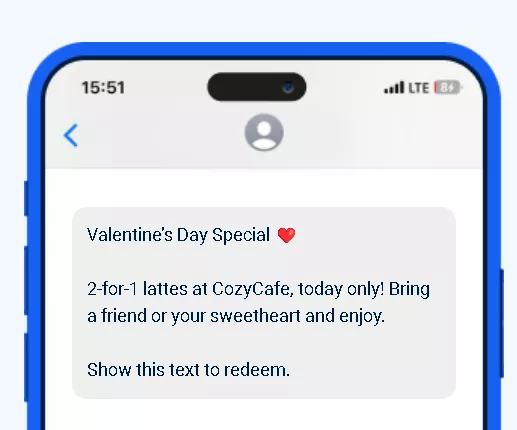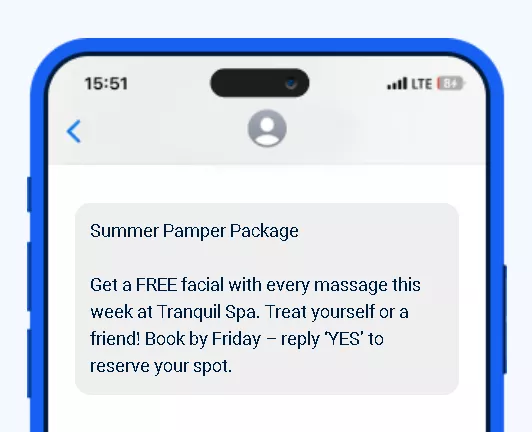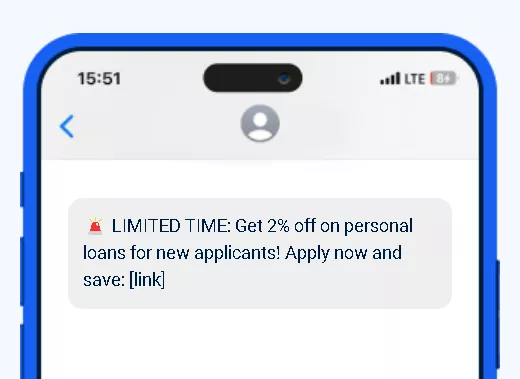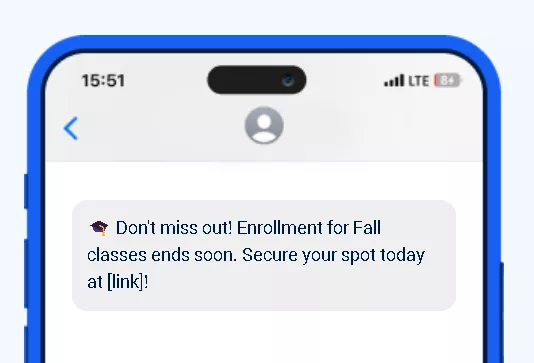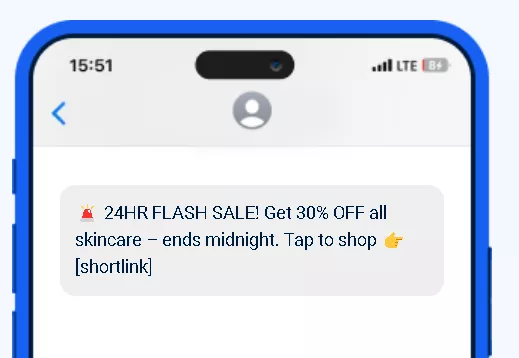Promotional Texts: Boost Your Sales With SMS Marketing — The Ultimate Guide for 2025
It’s 2025, and your customers’ phones are practically fused to their hands. Personal computers are gathering dust, tablets are playing second fiddle and wearables are still trying to figure out if they’re cool or just clingy. But smartphones? They’re the VIP pass to your customer’s attention.
Enter SMS (short message service) marketing — the bold, no-nonsense channel that doesn’t wait politely in the inbox or hide behind an algorithm. Unlike emails that get buried and ads that get skipped, a promotional text cuts through the noise and lands directly in the palm of your buyer. It’s instant, it’s personal, and when done right, it converts like crazy. Unlike other promotional channels, which are often ignored, SMS goes straight to your customer’s attention.
Promotional texts deliver fast and cost-effective results. They help you share real-time offers, generate instant interest and build lasting customer loyalty. If your business growth is your priority, SMS campaigns should be part of your marketing strategy.
Think of this as your ultimate cheat sheet for SMS marketing — minus the boring bits. We’re talking what it is, why it works and how to send messages people actually want to open.
What Are Promotional Texts? The Underrated Sales Tool in Your Pocket
Text message marketing is about sending text messages to customers or prospects to promote a product, offer a deal or deliver important information. SMS is a short, punchy, time-sensitive message sent directly to a recipient’s phone. There are two major types of SMS:
- Promotional message: Used to drive sales, announce events, share discounts and spark engagement
- Transactional message: Informational messages like order confirmations, delivery updates, appointment reminders, etc. that enhance customer experience
The main purpose of promotional texts as SMS marketing messages is to drive sales and better brand awareness. Use SMS to hit your customers with can’t-miss deals, early access invitations and exclusive perks — the kind of messages that don’t just get opened, they get results. Many promo text messages look like this:
Promotional texts are a form of A2P (Application-to-Person) messaging — meaning they’re sent from a business app, mostly from an SMS marketing platform — to a person’s smartphone. The main difference between promotional and transactional texts is that transactional texts are triggered by customer behavior or requests like order confirmations, shipping notifications or OTP verification codes. Compare:
|
Transactional SMS |
Promotional SMS |
|
Your package has been shipped. Track it here: https://delivery-1.com. |
Great news! Our latest collection is already here. Get 10% off with code NEW10. |
Why Are Promotional Texts So Effective?
Simple: because they actually get read. SMS campaigns cut through the clutter and deliver results — fast. In a world overflowing with emails, push notifications and algorithm-powered noise, promotional texts show up where your customers are already looking. Here’s why this old-school channel is still the MVP of modern marketing.
Sky-High Open Rates
SMS nearly always ensures your content gets seen. SMS has an open rate of around 98%, meaning that almost all messages are opened and read. It’s about 3.7 times bigger than email or social media. That’s why through texting, your carefully designed offer won’t get lost in a sea of spam.
Direct and Immediate Reach
Any user with or without internet access can receive promotional texts because they do not need any special software. This technology works on all devices with a GSM network. Significantly, people tend to check texts right away. Text messages don’t sit around — 90% of them get opened within three minutes, making SMS perfect for real-time promos and fast-moving offers.
Urgency and Timeliness
Consumers typically receive push notifications for messages, so an SMS feels more immediate than an email. Businesses can use this urgency for limited-time promotions such as “Today only” deals and or alerts when a sale is ending soon. The combination of an easy-to-read format and relevant content gets customers from “Hmm” to “Heck yes” in seconds.
Customer Loyalty
SMS often uses a natural conversational tone, creating an individualized connection that stands apart from standard ads. Personalize messages with the customer’s name, or tailor the content to their past purchases and preferences, making the message more relevant. Research shows that approximately 72% of consumers respond to marketing SMS that matches their concerns or desires.
Text, Tap, Convert: Why SMS Marketing Still Wins in 2025
Still not sold? Let’s review the SMS facts:
- 98% open rates: Compare that to the average email open rate of 20–25%. SMS gets seen.
- 90% of texts are read within three minutes: Timing is everything in marketing — and SMS wins.
- 45% average response rate: That’s miles ahead of email (6%) or Facebook ads (1–2%).
What’s behind that high performance? People are glued to their phones, and unlike email or social, texts still feel personal — not spammy.
Types of Promotional Texts — And How to Use Them Like a Pro
Promotional SMS isn’t just for shouting about a sale. It’s your tool to engaging customers with timely, targeted messages — from flash deals that light a fire under potential customers to loyalty perks that keep VIPs coming back. Whether you’re hyping a launch, offering a discount or just reminding someone their cart is lonely, there’s a text for that. The key? Matching the message to your goal so it feels relevant, not random. Let’s break down the types of promotional texts that actually get results.
Flash Sale Announcements
These text messages make use of time-sensitive offers and instant, substantial reductions. Fear of missing out (FOMO) is used to persuade customers to purchase immediately. Usually, flash sale notifications are delivered just before or at the beginning of the deal. For instance:
Early Access Offers
When you offer early access perks, subscribers don’t just feel special — they feel like insiders with VIP access. Bonus: it boosts sales and gives people a solid reason to join your SMS list in the first place. For instance:
Loyalty Program Updates and Rewards
Running a loyalty program? Don’t keep it quiet. Send point balance updates with a side of exclusive offers and heartfelt thank-yous. When you mix entertainment with value, customers stop feeling like transactions and start feeling like superfans. For instance:
Free Shipping
Got shoppers on the fence? Give ’em a gentle push. A promo code for free shipping or a bonus gift delivered via SMS can be just the incentive they need to hit “buy now.” For instance:
Seasonal and Holiday Discounts
Tie your promotions to the season or upcoming holidays to make them timely and relevant. Seasonal texts take into account what customers already care about and build excitement around your brand’s special offers during these periods. For example:
Cart Recovery
Abandoned carts = lost revenue. A friendly nudge — timed just right — can bring customers back before they bounce for good. Sweeten the deal with a limited-time offer or a small bonus, and suddenly that forgotten cart looks a whole lot more appealing.
Surveys and Feedback Requests
Want to know what your customers really think? SMS surveys are quickly seen and engaged with. Make it brief and straightforward, and give individuals a sense that their opinions count (a little prize can also help).
Best Practices For Better SMS Marketing
Writing a killer promotional SMS is like speed dating: you’ve got just a few characters to make a good impression, spark interest and get someone to say yes. Here’s how to nail it every time — legally, clearly and persuasively.
Always Get Consent
Before you start texting like it’s a group chat, pump the brakes — you need permission. SMS marketing laws like GDPR (Europe), TCPA (US) and others exist to protect consumers from spammy nonsense. Break them, and you’re looking at hefty fines and a brand reputation in freefall.
Make consent explicit. That means clear opt-ins — like a checked box, a “JOIN” text reply, or a signup form that spells out what users are agreeing to (including how often you’ll text and what kind of content to expect). And don’t forget: every message needs a clear way to unsubscribe. “Reply STOP to opt out” isn’t just polite — it’s the law.
Write Like a Minimalist With a Mission
SMS is not the place to ramble. You’ve got 160 characters to win someone over. Get to the point. Then get to the call-to-action (CTA). Write it. Then cut 20%. Keep trimming until your message reads like a confident elevator pitch, not a babbling monologue.
Be Direct and Use a Compelling CTA
Every SMS should have a CTA that makes it obvious what the customer should do next. Think:
- “Shop Now”
- “Use Code XYZ”
- “Tap to Claim”
- “Reply YES to Redeem”
No confusion. No fluff. Just click-worthy direction.
Time It Right
You want to send texts when customers are awake, alert and likely to act so as not to irritate them. Studies suggest the best times to send promotional texts are around lunchtime or early evening when people have a moment to check their phones — for instance, around 12 p.m. or 2 p.m., and again around 6–8 p.m. Basically, catch people when they’re not neck-deep in meetings or trying to wrangle toddlers.
Create a Sense of a Personal Touch
Personalization drives engagement. Even simple personalization like name, or referencing a recent purchase makes the customer feel valued. Most SMS marketing tools support merging tags or segments to personalize messages at scale. Use these features to your advantage — but double-check that your data is accurate.
Create Urgency
Urgency works — if it’s real. “Today only,” “Ends tomorrow,” and “Only for the first 100 customers” help drive action. But lie once about urgency, and your audience will ghost you faster than a bad date. Keep it real.
Test, Analyze and Refine
A/B testing isn’t just for email nerds — SMS marketers need it too. Try different offers, tones, CTAs and even send times. Does “50% off” outperform “Buy One, Get One”? Find out before you send it to your whole list. The goal? Learn what actually drives clicks, then double down.
Industries Crushing It With SMS Marketing
Some industries have already made SMS their MVP. Retail brands, appointment-based healthcare providers, beauty spaces, etc. — all benefit from text messaging when speed and direct communication matter most. Here are a few promotional text message examples.
Retail & E-Commerce
Retail and e-commerce companies, especially fashion brands, harness SMS messages to notify customers about orders, promote flash specials and remind customers about abandoned carts. Their customers are difficult to reach since they often have staffed inboxes and limited attention spans.
With its simple calls to action and immediate engagement, SMS breaks through the clutter like a knife through butter. For instance, a straightforward “Final hours! Get 30% off everything with code FINAL30” can encourage hurried purchases and lower cart abandonment rates.
Hospitality
In hospitality, speed and clarity aren’t just nice — they’re expected. Whether it’s a hotel, restaurant or your favorite neighborhood café, guests want instant booking confirmations, helpful reminders and irresistible offers — all without calling the front desk or checking their spam folder.
That’s where SMS shines. A quick text slashes no-shows, keeps bookings on track and lets you send tempting deals straight to the people most likely to say yes. Think:
“Reserve by 6 PM and get a free dessert!”
SMS helps you stay top-of-mind (and top-of-inbox), making real-time communication feel effortless and personalized — the way hospitality should.
Healthcare
Every day, healthcare practitioners send SMS to convey test results, reduce the number of missed visits and remind patients about follow-ups or vaccinations. While phone conversations are time-consuming and email reminders get ignored, SMS reminders like “Your appointment is tomorrow at 10:30 a.m.” work the best. This cuts down on no-shows and saves valuable staff time.
Real Estate
SMS is a hands-on tool used by real estate agents to warm and nurture leads, since the sales funnel can be pretty lengthy. Estate agencies can streamline processes like scheduling showings, alerting clients of new listings, etc. Lost or unopened emails cost you deals. That’s why keeping leads interested and responsive with a brief “Just listed! 2BR condo in Downtown — open house this Saturday” SMS is a game-changer.
Finance
SMS gives finance brands serious power — especially when security and speed are non-negotiable. From real-time account alerts to payment reminders and timely promo offers, financial brands use SMS to stay one step ahead of the inbox clutter.
Customers crave instant info they can trust. A message like:
“Refinance by April 30 — 0% processing fees!”
cuts through the noise and gets noticed way faster than a newsletter buried in spam or a call that goes straight to voicemail.
Even a quick “Reduce your monthly payments — check your new rate now” can drive action, build loyalty and keep customers engaged. Because when money’s involved, people want clarity — fast.
Education
Educational institutions, from schools to online platforms, rely on SMS to reach both students and applicants. Emails get ignored, social posts get lost in the algorithm, and suddenly your important update is yesterday’s news.
That’s why educational institutions are turning to SMS. It’s fast, direct and actually gets read. Want to boost class attendance or enrollment?
Try: “Save your seat for summer classes — registration ends Friday!”
That one text could be the difference between a full course and an empty classroom.
Beauty brands
Exclusiveness, one-time releases and trend-driven excitement are what fashion and beauty brands thrive on. Unlike the restricted reach of social media, SMS fills the gap by delivering buzz directly to the customers. Notifications such as “New arrivals have just landed! Get 15% off today only when you shop the Spring Collection first” create a sense of urgency and exclusivity. As a result, sales skyrocket right away.
No matter your niche, if your customers have phones — you have an audience.
How to Build an Effective SMS Marketing Strategy
Now let’s get strategic. Here’s how to design an SMS marketing campaign that genuinely increases conversions.
Step 1: Grow a Compliant SMS List
Before you send a single message, you need clear, express permission. No shortcuts — regulations like GDPR and TCPA make it mandatory. To grow your SMS list the right way, use pop-ups on your website, add an opt-in option at checkout, and promote your list on social media, through email, or even in-store. Offering a little incentive, like a discount code or early access to sales, goes a long way in encouraging sign-ups. No consent means no messages. It’s that simple.
Step 2: Segment Your Audience
The more tailored your message, the better the results. New subscribers respond well to welcome series and first-purchase offers, while big spenders appreciate VIP perks and exclusive early access. Inactive users can be re-engaged with win-back campaigns, and location-based messaging is perfect for promoting in-store offers or inviting customers to nearby events. In short, segmentation leads to personalization — and that’s what drives conversions.
Step 3: Craft Killer SMS Copy
With only 160 characters to work with, every word matters. Start strong by leading with a hook — whether it’s a discount, a limited-time offer or a direct benefit. Action verbs like “Shop now,” “Claim your code,” or “Tap here” drive momentum and tell your audience exactly what to do next. Make sure your CTA is clear, and include a link for easy access. To boost conversions, add urgency or scarcity — phrases like “Today only” or “Only 20 left!” can make all the difference.
Keep it short. Keep it snappy. Keep it clickable.
Step 4: Time It Right
The best times to send promotional SMS messages are when your audience is most likely to check their phones without being distracted.
Avoid sending messages in the early morning, late at night or on Sundays, when people are less receptive. To truly optimize performance, run A/B tests based on your audience’s behavior and region to fine-tune your send times.
Step 5: Track, Analyze, Repeat
The metrics that matter in SMS marketing go beyond just sending messages — they tell you how well your campaigns are performing and where you need to adjust. Delivery rate shows whether your messages are actually reaching real, active numbers.
Open rate — though often inferred from clicks or replies — gives a sense of how engaging your message was at first glance. Click-through rate (CTR) tells you how many recipients were intrigued enough to take the next step. Conversion rate is where the rubber meets the road: how many people actually bought, signed up or booked after clicking?
And don’t ignore your unsubscribe rate — a spike here often signals you’re targeting the wrong audience or sending too frequently. Track, tweak and test constantly like a scientist seeking empirical evidence.
Common Mistakes to Avoid In Promotions
Research shows that more than 23% of consumers abandon a brand if they feel bombarded by spam SMS. Even the best marketing ideas can backfire if your execution fumbles the ball. Marketers should be careful to avoid these common mistakes:
Too Many Texts
If you’re texting users every day (or multiple times a day) without good reason, it's probably too much. Remember that SMS is a highly attentive channel, so treat it with respect. It’s much better to send one or two effective messages a week than to overwhelm users with noise.
Poor Timing
No one wants their smartphone buzzing with a marketing text while they’re sleeping. Try to send messages during windows when people are free to read and act. A good practice is to stick to daytime and early evening slots. For example, between 9 a.m. and 8 p.m. time, depending on your audience’s habits.
Weak or Missing Call-to-Action
Every promo text should tell customers what to do next. Otherwise, the impact will be minimal. Don’t just assume that the customer will take the initiative to find your site or store — guide them. Also, make the CTA stand out by its placement or using caps.
Non-Personalized Messaging
Segment your audience and tailor messages when possible. If you have data on purchase history or preferences, use it to your advantage. Personalize the greeting with a name if you have it.
Using All Caps or Spammy Language
Avoid using all caps or spammy phrases like “buy now!!!” or “freeeeee!!!!” if you want to stay out of the spam folder. Overhyped language makes your message look suspicious and turns off loyal customers fast. Keep your tone clear, professional and enthusiastic without going overboard. You can be exciting without sounding like a late-night infomercial.
Forgetting Opt-Out Instructions
Forgetting to include opt-out instructions like “Reply STOP to unsubscribe” damages trust and gets you into legal trouble. Every SMS should give people a clear and easy way out, or you risk fines and a frustrated audience. Sending texts to people who didn’t opt in is a recipe for irritating recipients and potentially violating laws like the Telephone Consumer Protection Act. It’s also important to make it easy to stop receiving messages.
Not Testing Links
Not testing links or messages before a big send can lead to embarrassing mistakes and missed opportunities. A broken link, wrong promo code or typo can turn a carefully planned campaign into a disaster. Testing ensures your SMS content appears as expected, links correctly and the message delivers the intended experience. Always double-check your content before hitting send to avoid costly errors and maintain a professional image.
SMS Marketing Tools to Power Your Campaigns
No one’s hand-typing promotional texts like it’s 2002. That’s a fast track to burnout and typos. If you're serious about SMS marketing — even in the early stages — you need a platform that can do the heavy lifting for you.
Here’s what a solid SMS tool should bring to the table:
- Automation. Schedule messages ahead of time, or trigger them automatically based on customer behavior — birthdays, abandoned carts or post-purchase love notes.
- Personalization. Dynamic fields and segmentation are automated through API from your CRM. Insert the customer’s name, reference a product category they like, etc.
- Analytics and reporting. Track what’s actually working. From delivery rates to click-throughs, real-time analytics show you which messages hit and which ones fell flat.
- Templates and campaign management. Save message templates for future use, so you don’t have to begin composing messages from scratch every time.
Bottom line: A great SMS platform doesn’t just send messages — it helps you scale smart. Automate, personalize, analyze, repeat. The right tools turn your SMS game from basic to boss-level.
SMS Texting for Banking: Case Study
JSC Sense Bank, a top Ukrainian financial bank, relied on us to implement a safe, instantaneous connection with its customers on many levels. These messages were designed to improve the transparency, security and trust of the banking experience. In particular, customers could follow account activity, receive one-time passwords (OTPs) and monitor financial operations through the mobile banking platform, Sense SuperApp.
To meet the standards and industry expectations, Sense Bank teamed up with DecisionTelecom within and without Ukraine: throughout Europe, Asia and the Americas. As a result of this strategic partnership, Sense Bank has improved client satisfaction, ensured data security and supported the bank’s digital expansion with scalable, real-time messaging.
Smarter Texts, More Sales
At the end of the day, SMS marketing works — but only if you do it right. When done well, promotional texts aren’t just messages — they’re money-makers.
We’ve covered the best practices, pro tips and tools you need to send texts your customers actually want to receive. And thanks to user-friendly platforms, even the smallest business can launch smart, personalized, high-converting campaigns — no marketing degree required.
So here’s your sign: stop sending emails into the void and start texting like a brand that knows what it’s doing. Your customers are already staring at their phones.
The opinion of the author of the guest post may not reflect the position of the editorial board and specialists of Netpeak Agencies Group.
Related Articles
Display Advertising Effectiveness Analysis: A Comprehensive Approach to Measuring Its Impact
In this article, I will explain why you shouldn’t underestimate display advertising and how to analyze its impact using Google Analytics 4
Generative Engine Optimization: What Businesses Get From Ranking in SearchGPT
Companies that master SearchGPT SEO and generative engine optimization will capture high-intent traffic from users seeking direct, authoritative answers
From Generic to Iconic: 100 Statistics on Amazon Marketing for Fashion Brands
While traditional fashion retailers were still figuring out e-commerce, one company quietly revolutionized how U.S. consumers shop for everything from workout gear to wedding dresses

